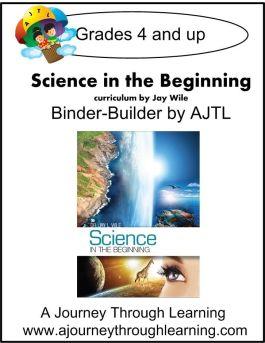There are three Binder-Builders™ thus far for Dr. Jay Wile’s Science in History curriculum for the elementary grades—one for each of the first three books in the series: Science in the Beginning, Science in the Ancient World, and Science in the Scientific Revolution. (You need the textbook that goes with each Binder-Builder.) These Binder-Builders were created with the approval of Dr. Wile who says, "Craft-oriented children will love using these Binder Builders to review the things they are learning in my elementary courses!" While Dr. Wile's textbooks are for grades one through six, the Binder-Builders are only for grades four through six.
Think of each Binder-Builder as a combination of a notebook and a lapbook. They reinforce what students are learning in the textbooks, and they provide a single place for students to collect and present all of their work for each course.
Each Binder-Builder is a PDF file with more than 400 pages to print out on regular copy paper. Some pages will be cut up and folded, stapled, or glued to make mini-booklets that will be mounted on cardstock pages in the binder. Other Binder-Builder pages are worksheets for students to complete. Everything is assembled or collected into your own three-inch-thick, three-ring binder.
Other resources you will need along with each Binder-Builder PDF and a binder are 90 pieces of 8.5 x 11 colored cardstock, scissors, glue (Zip Dry™ Glue is recommended), a three-hole punch, brads, a stapler, crayons or colored pencils, and either four or five tabbed separator pages. You will probably want assorted colors of cardstock. I found two large assortments at Amazon that provide more than you need, and I’ve included those below in the pricing section.
All of the Science in History courses have six units with 15 lessons per unit─90 lessons in all. The Binder-Builders mirror that layout for six units, and the 90 cardstock pages give students a two-page spread for each lesson. The first part of the binder will be created on the cardstock pages. On the cardstock pages, students will glue a title page for each unit and two or three mini-booklets per lesson. Students that fit into Dr. Wile's categories of older and oldest will also complete a journal page for each lesson that will go into this section of the binder. (As Dr. Wile explains, parents need to use their discretion as to how to categorize their students as youngest, older, or oldest.)
You will label the tabs on your binder separator pages with Key Persons, Vocabulary, Experiments, and Books, adding a fifth tab for Memory Work for Science in the Beginning. For each unit, the Binder-Builders have a unique set of forms that will be used for these tabbed sections in the binder. You will make copies of each set of forms so that students can complete them for each lesson within the unit.
Here is an example of how this works with one of the types of forms. The Key Person forms are identified as belonging to a particular unit, but the same form will be used with all lessons in that unit. The Key Person forms have space for a picture of the person and another space for a picture of their discovery, invention, or topic to which they are related. There are lines for students to write in the key person’s name, date of birth, date of death, why they are famous, and something about their discovery or invention. A number of key people might be encountered in one unit and none in another unit, so parents can help students decide which ones to include.
All 90 of the lessons have two or three mini-booklets that students of all ages will construct and write in. These can be printed on plain white paper, and students can color them with crayons or colored pencils. You might want to print some of them on colored paper to make them more attractive without coloring. (It depends how much your children enjoy coloring.) The questions covered in the mini-booklets are those at the end of each lesson in the textbook that are identified for the youngest students (rather than for older and oldest students).
The textbooks also have questions designated for older and oldest students, and students in those categories will answer their questions on the journal page forms for either older or oldest students.
Vocabulary words and their definitions will be written on the forms that will be kept behind the Vocabulary tab. Experiment forms are to be used for recording information about each experiment: materials needed, what was done, and what the student learned. The Book form is to be used to list any additional books that were used for the unit. The Memory Verse form (found only in Science in the Beginning) is a copywork page with a verse that is to be copied and memorized.
The Science in History series requires students to maintain a notebook for their work, even if it is not done with a Binder-Builder. The Binder-Builders provide pre-formatted pages for students to do their notebook work, a big help in itself. Some students might think that creating the mini-booklets is a waste of their time, and it might be if it does not suit their learning style. On the other hand, the creation of mini-booklets should help many students learn key points more effectively, and the arts-and-crafts aspect of the mini-booklets might make learning science more enjoyable.










